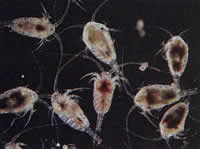|
The Project
 Research Methods Research Methods
 Research Questions Research Questions
The Locations
How to Use This Site
Links
Part 1:
January 25 - February 9, 2005
The Team
Daily Journal
New Horizon Daily Report
New Horizon Cruise Track
Part 2:
July 23 - August 13, 2005
The Team
Daily Journal
New Horizon Daily Report
New Horizon Cruise Track
Part 3:
August 30 - September 8, 2005
The Team
Daily Journal
R/V Wecoma Daily Report
R/V Wecoma Cruise Track
Contact Us

|
Daily Journal |
Part 2
July 23 - August 13, 2005
|
07 August , 2005
More from The Log from the Sea of Cortez
The disappearance of plankton, although the components are microscopic, would probably in a short time eliminate every living thing in the sea and change the whole of man’s life, if it did not through a seismic disturbance of balance eliminate all life on the globe. For these little plants and animals, in their incalculable numbers, are probably the base food supply of the world.

What is plankton?
Plankton comes from a Greek word that means “to wander.” Plankton drift about the seas and fresh water, pushed by currents and wind; they have little or no ability to propel themselves. There are two major types of plankton: phytoplankton (plants) and zooplankton (animals). Some plankton are microscopic; others can grow large enough to be seen by the human eye. Jellyfish are considered a type of plankton because they have limited ability to direct the course of their movement.
 Phytoplankton consists chiefly of simple, one-celled algae, that use the energy of the sun to grow and reproduce. This process is called photosynthesis. It’s the same process by which trees on land grow. Phytoplankton consists chiefly of simple, one-celled algae, that use the energy of the sun to grow and reproduce. This process is called photosynthesis. It’s the same process by which trees on land grow.
Phytoplankton, using only sunlight and the minerals in water, grow in a process called photosynthesis which produces oxygen…lucky for us. Scientists describe this process using the following equation:
CO2 (carbon dioxide)+ fertilizers + H2O _ CH2O (carbohydrate) + O2 (oxygen)
The appearance of plankton in the ancient seas (about 3 _ million years ago) began to change the content of the Earth’s atmosphere by adding oxygen. I think it’s safe to say that without plankton, the Earth today would be uninhabitable for all animal (including human) life. And if all the plankton on Earth were to disappear, life in the seas would die off, too, because plankton is the base of the food chain. Today, 60% of the protein that humans consume comes from the sea. How would the extinction of plankton affect your life?
The scientists onboard the R/V New Horizon are studying what controls the growth of ocean plants and how this growth has an impact on the animals and fish higher up the food chain.
 Copepods are teeny crustaceans (about 1/24 of an inch). A crustacean is an invertebrate animal with many jointed legs and a hard external shell. Copepods are teeny crustaceans (about 1/24 of an inch). A crustacean is an invertebrate animal with many jointed legs and a hard external shell.
A crustacean has no bones. The external shell, called an exoskeleton, covers and protects the body. Crabs, crayfishes, lobsters, and shrimp are crustaceans, as are barnacles, water fleas, and wood lice.
Tomorrow: tune in to learn about the “biological pump” that connects the atmosphere and the ocean.
Math Problem:
The R/V New Horizon holds 43,589 gallons of diesel fuel. If the ship cruises at 10 knots and makes no stops and starts, it burns about 1500 gallons of fuel a day. How far can the ship travel without refueling?
By the way, the ship doesn’t have to pay road taxes on the fuel it buys because it’s burned at sea.
Trivia Tidbit of the Day:
Unlike land turtles, sea turtles cannot withdraw into their shells. They depend on their size and swimming speed for defense.

|







